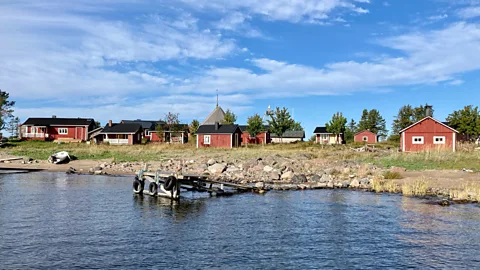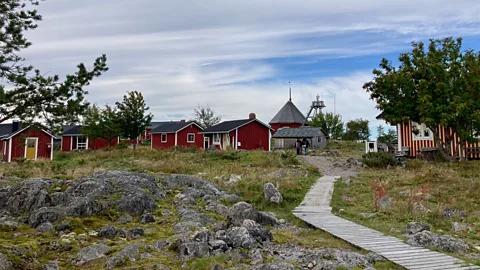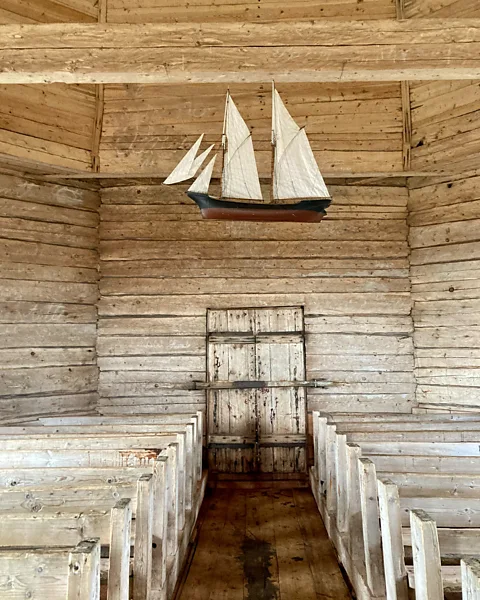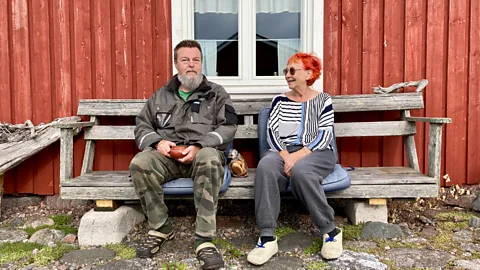Maakalla: Europe's isolated, autonomous island
 Pooja Naik
Pooja NaikAdrift off the Finnish coast, this small island comes alive each summer and offers a fascinating glimpse at how Finns once lived.
It's late September and a handful of trees sprouting wild berries are the last signs of life on Maakalla, a lonely island cast 18km off Finland's western coast in Bothnian Bay. When winter comes in a few days' time, they will be buried under a veil of white snow. But right now, the sky is the spent blue of a retreating summer, glinting off the roofs of the empty wooden cabins that dot the 20-hectare island. "I believe we're the only ones here," whispers Martta Tervonen, my guide for the day.
With a playlist of crashing waves on loop, Tervonen and I stroll across the island's stony pathways. "You know, when the island was discovered [by fishermen and seal hunters in the 15th Century], it was only 9mm above the water's surface," explains Matti Hautala, the boat captain who ferried us here from Keskuskari harbour on the mainland. Everything around me was once submerged under water, but each year since the weight of Ice Age glaciers that once covered this area melted more than 10,000 years ago, the land holding Bothnian Bay continues to slowly rise – a phenomenon known as glacio-isostatic uplift. Today, the island is more than 5m above sea level.
One sweep of my surroundings and I quickly realise there is nothing conventional about Maakalla. There are no shops, restaurants, cars, roads, guesthouses or – for the most part – even people here, just the skulls of seals mounted on the front doors of empty cabins. That's because, as this small island slowly rose from the sea, it and the surrounding area became a key Baltic herring fishing hub. But as farming and other industries grew in the late 19th and early 20th Centuries, fewer and fewer of the roughly 700 fishermen who used to flock here each summer from the nearby Kalajoki region needed to spend these long, lonely periods away from their families.
Today, just a small fraction of these fishermen return to their families' ancestral cabins each summer, bringing enough water, wood and other supplies they need to survive. During these weeks- or months-long stretches from May to September, this ghost town reawakens, as day-trippers trickle in to catch a glimpse of the customs and traditions that Finns once embraced.
 Pooja Naik
Pooja NaikAlthough technically belonging to Finland, Maakalla enjoys autonomous status and is governed by a council of local fishermen elected every summer. The tradition dates to 1771 when Finland was under Swedish rule and King Adolf Fredrik granted Maakalla a special status of self-governance due to its far-flung nature. In 1809, Finland fell under Russian control before eventually declaring independence in 1917. Despite maintaining neutrality during the Cold War, Finland joined the European Union in 1995 and applied for Nato membership after the 2022 Russian invasion of Ukraine. Interestingly, Maakalla is part of neither alliance.
As Hautala explains, "Nobody lives here permanently."
As the surrounding waters transform into a sheet of ice each winter, the island is completely cut off from the mainland. "Around 20 people stay here in summer, and a few day-trippers, but it is deserted for the rest of the year." Therefore, Maakalla's fishermen live by dual laws: during the weeks or months they're on the island, they're ruled by the council they elect; when they're back on the mainland, they're EU- and Nato-abiding members, just like everyone else in Finland.
Hautala comes from a long line of local fishermen, and his grandfather once owned one of the Maakalla's kalamaja (a traditional fisherman's hut that can only be inherited through ancestry). When Hautala was 10, his grandfather relinquished the cabin when he grew too old to maintain it, and according to local custom, there's no way for him or his family to reclaim it. "None of the huts here can be bought or sold," he responds softly. "I tried a lot, but have not been able to succeed."
 Pooja Naik
Pooja NaikWhen the nearly identical huts, painted in deep red tones, were constructed in the 1700s, there were approximately 150 of them. Today, less than 50 huts remain, and their survival rests in the hands of the council.
We soon stop before a large moss-coated rock surrounded by smaller, toadstool-like stones. "This is where the island's council gathers for kari ('small island') meetings every summer on the Sunday closest to St James's Day (25 July) to elect members and make other important decisions," such as deporting fishermen guilty of crimes committed on the island – which rarely happens.
A little further stands the tiniest lighthouse I have ever laid my eyes on. No taller than an average adult, the fixture stands on a pile of rocks. "It's for the boats to locate the island," Tervonen explains. Local custom dictates that anyone who visits Maakalla must take the first stone that they step on and add it to the lighthouse's growing heap to raise its height.
As the wind howls, we seek refuge in a nearby cabin, which Hautala explains was once the island priest's home. "In olden days, the island appointed its own priest, who also served as the mayor, and this is where he lived," Tervonen says. "But now, only a mayor is chosen every year, and the priest visits to inaugurate the council ceremony and to officiate weddings at the chapel."
 Pooja Naik
Pooja NaikOur exploration leads us to the newly built Maakalla Museum, which displays historical artefacts and supporting text in Finnish. Black-and-white photos and old maps of the region adorn the walls. Stone slabs cover the tops of fishermen's buckets, which were used to store Baltic herrings. But it's the details about seal hunting that pique my interest.
Visiting Maakalla
Travellers can only visit Maakalla with a boat and a private guide. SeaFox Kalajoki operates three-hour ferry excursions departing from Keskuskari harbour from May to October. A 4.5-hour trip aboard the Galeas Ansio sailboat leaves from Konikarvo harbour and include a visit to the island, a fish soup meal, coffee and refreshments.
"Around [late] spring, when the ice is still intact [but starting to melt], the seal hunters [on Maakalla] set out on their boats and head to the middle of the sea," Hautala says. "It is where the seals live all year around. There are too many of them, and they end up eating all the fish in the waters." Hautala explains that Maakalla residents believe the age-old practice of seal hunting helps regulate seal overpopulation.
Perhaps the island's most striking man-made feature is its 1780-built wooden church and belltower. Its facade is splashed in red while the doors and windows drip egg-yolk yellow. Fittingly, the church's ceiling is designed to resemble an inverted ship; its ends are shaped like a bow and stern; and instead of a cross, a large wooden boat hangs in its centre. Hautala explains that throughout the centuries, most fishermen on Maakalla got married here, and in an unexpected twist, the church has now become popular with destination weddings.
More like this:
• Europe's 500-year-old seafood tradition
• The secret meaning behind the World Tree Hugging Championships
It takes less than 45 minutes to traverse the island by foot, and just when I thought I had seen it all, an elderly woman with fire-coloured hair suddenly emerges from her cabin, chatting with a gentleman drinking coffee on the bench outside. The couple is Maakalla's last residents of the season.
 Pooja Naik
Pooja NaikI discovered that the woman's name is Marja-Liisa and the cabin belonged to her father, who built it in the 1950s. Growing up, she spent most summers in the hut with her parents and older siblings. A picture from one such family holiday is still framed inside, and a wooden nameplate with all their engraved names hangs above the front door. Now in her late 70s, she lives here with her husband for up to five-week stretches each summer.
"It's so peaceful and lovely here," Marja-Liisa says, adjusting her sunglasses. She explains that even though electricity is now generated by solar power, islanders still need to bring enough supplies to last their stay. With no shops or farms on Maakalla, the only consistently available food source is whitefish – an island staple that is freshly caught and smoked on coals – occasionally served with rye bread and cheese.
Indoors, pastel curtains filter sunlight that slowly fills the kitchen and a kettle boils to a scream. Due to the island's limited resources, it is common to use seawater in cooking, and Marja-Liisa's morning cup of coffee is no exception. "I love sea buckthorn and lingonberries from here, and they often make their way into my breakfast porridge," Marja-Liisa adds, gesturing towards the window to show where she forages for the ingredients.
 Pooja Naik
Pooja NaikWe step onto the veranda, and her husband offers us korppu (traditional cinnamon- and sugar-dusted rusks). It is the couple's final weekend on Maakalla; soon they will return to their home in Kalajoki until next summer. I ask if I can take a picture, and she swiftly slips into her "nice" pair of shoes and smiles for me. As we say goodbye, I learn that the couple was married at the island church 45 years ago and have visited together every year since.
Having marvelled at Maakalla's impermanence all day long, I suddenly discover its endurance.
--
If you liked this story, sign up for The Essential List newsletter – a handpicked selection of features, videos and can't-miss news, delivered to your inbox twice a week.
